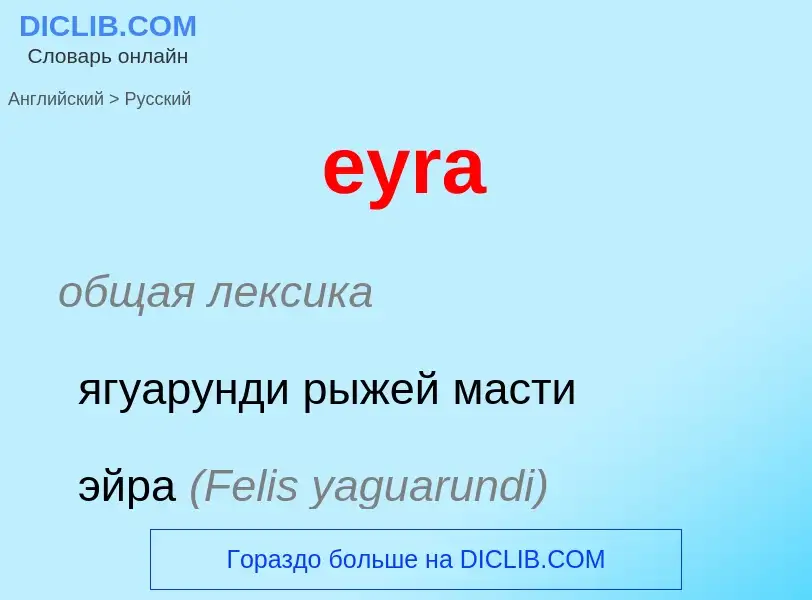Translation and analysis of words by ChatGPT artificial intelligence
On this page you can get a detailed analysis of a word or phrase, produced by the best artificial intelligence technology to date:
- how the word is used
- frequency of use
- it is used more often in oral or written speech
- word translation options
- usage examples (several phrases with translation)
- etymology
eyra - translation to russian
общая лексика
ягуарунди рыжей масти
эйра (Felis yaguarundi)
[dʒægwə'rundi]
общая лексика
ягуарунди (Felis yagouarundi)
существительное
зоология
ягуарунди
американская дикая кошка (Felis eyra)
Definition
Wikipedia

The jaguarundi (Herpailurus yagouaroundi; or ) is a wild cat native to the Americas. Its range extends from central Argentina in the south to northern Mexico, through Central and South America east of the Andes. The jaguarundi is a medium-sized cat of slender build. Its coloration is uniform with two color morphs, gray and red. It has an elongated body, with relatively short legs, a small, narrow head, small, round ears, a short snout, and a long tail, resembling mustelids in these respects. It is about twice as large as a domestic cat (Felis catus), reaching nearly 360 mm (14 in) at the shoulder, and weighs 3.5–7 kg (7.7–15.4 lb).
Secretive and alert, the jaguarundi is typically solitary or forms pairs in the wild, though captive individuals are more gregarious. Unlike other sympatric cats such as the ocelot, the jaguarundi is more active during the day and hunts mainly during daytime and evening hours. Individuals live in large home ranges, and are sparsely distributed within a region. The jaguarundi is an efficient climber, but typically prefers hunting on ground. It feeds on various kinds of prey, especially ground-feeding birds, reptiles, rodents and small mammals. Mating occurs throughout the year, with peaks at different times of the year across the range. After a gestation period of 70 to 75 days, a litter of one to four kittens is born. Lifespans of up to 15 years have been recorded in captivity.
The jaguarundi inhabits a broad array of closed as well as open habitats ranging from tropical rainforests and deciduous forests to deserts and thorn scrubs. It is fairly common in Brazil, Peru, and Venezuela, but may be locally extinct in the United States. It is listed as Least Concern on the IUCN Red List, but populations are in decline in many parts of its range due to loss and fragmentation of habitat and persecution for killing poultry.


.jpg?width=200)
![In the [[Děčín]] zoo, [[Czech Republic]] In the [[Děčín]] zoo, [[Czech Republic]]](https://commons.wikimedia.org/wiki/Special:FilePath/Herpailurus yagouaroundi Jaguarundi ZOO Děčín.jpg?width=200)

![generalist]] carnivores generalist]] carnivores](https://commons.wikimedia.org/wiki/Special:FilePath/Puma yagouaroundi, ZOO Praha 254.jpg?width=200)
